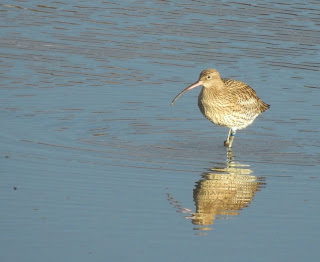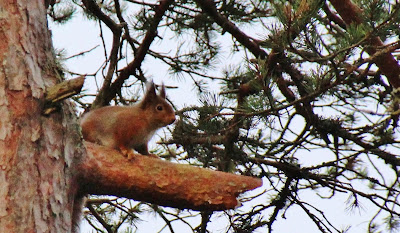January 2018 was our snowiest and coldest month for several years in the Cairngorms National Park, with temperatures regularly falling well below zero, and some nights seeing minus 13c, and with regular heavy snowfall and occasional blizzards, good wildlife watching days were few and far between! So my report may be a little shorter than usual, and may include some photos taken on January safaris from previous years...However, by being flexible, and cherry-picking the best days weather-wise, we did still manage some pretty enjoyable adventures out 'in the field', with the excellent off-road and winter weather abilities of my Land Rover Discovery often proving to be a necessity rather than a luxury!
On a more positive note, the days are noticeably lengthening now, with over 9 hours of usable daylight, and dawn (for the Black Grouse) is still a relatively sociable 7:30am.
Full-day local safari bird lists usually topped-out in the 40's, though a trip to the nearby Moray Coast can boost this total considerably, whilst mammal day lists varied between 4 and 8 depending on the time of our start and number of habitats visited, with early starts proving to be best.
 |
| An atmospheric River Spey |
To give you an idea of what you may realistically hope to see if you are planning a future January visit yourself, I hope the following more detailed information, illustrated with photos taken by myself , my friends or my safari clients will help - clicking on the picture will enlarge it to full screen.
Wildlife highlights included:
Local speciality/upland bird species seen regularly during the month included:
Black Grouse (at dawn only),
Red Grouse,
Crested Tit,
Dipper , White-Tailed Eagle and
Golden Eagle, and we also had a few decent sightings of
Snow Bunting, and just a few brief glimpses of
Crossbills. Winter visiting birds were represented by family groups of
Whooper Swans and
several species of 'grey'
Geese, ..and a few
Bramblings and
Redpolls were seen......
Mammals seen regularly locally during the month included:
Red Deer,
Roe Deer,
Reindeer,
Red Squirrel,
Rabbit,
Brown Hare,
Mountain Goat and
Mountain Hare (white), with just a couple of sightings of
Sika Deer and
Bank Vole...
Whilst a couple of trips to the moray Coast gave good views of both
Common and
Grey Seal...
 |
| Black Grouse |
The middle of the month saw our local
Blackcocks become noticeably more numerous, and considerably more aggressive at their dawn (around 07:30 am) leks, as they prepare to ramp things up for the forthcoming breeding season, with up to 9 blue-black male birds being seen attempting to stake their claim for mating rights with the hen birds in the spring with much posturing and squaring up to rivals, and the frostier mornings providing the best performances.....though it should be noted that they can fail to show at all on wet and windy mornings.....
 |
| Red Grouse |
Similarly, on our local upland moorlands, the cock
Red Grouse also seem to be upping the aggression levels, as they too seem to be seeking to establish a territory, attract females and repel their rivals, their guttural 'go-bak, go-bak' calls echoing across the otherwise empty moor, and alerting us to their presence in the heather.....and by using my safari vehicle as a kind of mobile hide, we managed some great close-up views...
 |
| Crested Tit |
Our local
Crested Tits continued to show well at my favourite forest feeding stations, especially soon after dawn, and particularly on the colder days, when they are presumably at their most desperate for food, with up to 4 of these true 'local specialities' showing at once...
It is worth noting that the winter months (October-March) are actually the best time of year for seeing the 'wee Cresties', as these characterful little birds can be frustratingly secretive and unobtrusive during the breeding season....
Still in the Caledonian pine forests, rather frustratingly,
Crossbills continued to be a bit of a 'bogey-bird', with sightings restricted to snatched glimpses of calling birds flying around the tree tops...though this may change soon, as the males should start to sing from the treetops, as they are very early breeders....
 |
| Dipper |
On the rivers, our local
Dippers continued to entertain, with their rarely-heard rippling warble of a song being projected proudly from a prominent rock soon after dawn as they presumably attempt to proclaim their ownership of the territory, and attract a female...
 |
| Golden Eagle by Steve Nicklin |
January is normally a pretty decent month for sightings of birds of prey in this area, but the wild and wintry weather and the consequent lack of safari bookings restricted my visits to the remote local upland glens to a handful of opportunities, though
Golden Eagle,
White-Tailed Eagle,
Common Buzzard ,
Sparrowhawk and
Kestrel were still all seen....which is pretty decent I reckon...
 |
| Snow Buntings |
The heavy snowfall actually worked to our advantage where
Snow Buntings were concerned, as they were driven down from the inhospitable mountain tops to known lower altitude sites, where a sprinkling of wild bird seed , plenty of patience and some warm clothes gave us some decent sightings of flocks of up to 30 birds....
The Arctic style weather (and multitudes of noisy snowsports enthusiasts!) dissuaded me from making any ventures up into the Cairngorms snowy tops this month..... so sadly I have no information about the
Ptarmigan to report..
 |
| Whooper Swans |
Whooper Swans could still be seen on local lochs, though they became more mobile and elusive, seemingly transferring to the rivers and flooded fields when the lochs froze over....
Greylag Geese and
Pink-Footed Geese were both noted locally, seen on lochs, rivers or fields, depending on the weather....
 |
| Waxwing by Steve Nicklin |
The cold weather seemed to bring a few small flocks of
Waxwings over the North Sea into our area, and I managed to get my 'year-list tick', in the somewhat less than scenic setting of Aldi car Park in Inverness!!! Seems like
Waxwings can't resist a bargain too........
 |
| American Wigeon |
The Moray coast is only about an hours drive North East of Aviemore, and a couple of trips to favourite reserves, lochs, bays and harbours gave good views of winter visitors such as
Greylag Geese,
Barnacle Geese,
Pink-Footed Geese,
Brent Geese,
Whooper Swan,
Wigeon,
Teal,
Pintail,
Bar-Tailed Godwit,
Knot, Golden Plover , and
Grey Plover, and I also managed to see an
American Wigeon... whilst a trip a little further north to Loch Fleet rewarded me with my first
Shorelarks for many a year...
 |
| Bar-Tailed Godwit |
Other good birds reported locally this month included: Kingfisher, Twite, Iceland Gull and Glaucous Gull....
Onto mammals now...
 |
| Mountain Hare by Steve Nicklin |
Our local Mountain Hares are now at their most splendid, their winter-white coats giving them an amazingly 'cute' appearance, that is actually quite at odds with their true character... in reality, these are incredibly hardy animals that can survive the toughest weather that winter can throw at them...
 |
| Red Deer |
Up in the glens, the Red Deer, in their large same-sex herds, were seen 'digging' through the often deep snow to get to the grass below...though if it gets too deep, they will temporarily vacate the mountain tops for the forests below....
 |
| Red Squirrel |
With natural food at it's most difficult to find, our Red Squirrels were not shy in visiting forest feeding stations for the free feasts on offer, which makes it much easier for my safari clients to see them, as they can be surprisingly elusive in the forests....
 |
| Roe Deer by Steve Nicklin |
As I suggested last month, Roe Deer are probably much more common and widespread than most people realise, but their nervous disposition and mainly crepuscular nature means that unless you visit fairly quiet sites and are out and about early or late in the day, you can easily miss seeing them...
 |
| Feral Mountain Goat |
Our feral Mountain Goats were a bit elusive this month, and I suspect that they may have temporarily vacated the mountain tops for the shelter and safety of the forests, as they usually give birth to their cute youngsters early in the new year....
 |
| Common Seal |
As I mentioned earlier, the sheltered harbours of the Moray Coast gave great views of both Common and Grey Seals, that seem to be relatively unconcerned by us humans, often giving great photo opportunities....
Well, despite the particularly wintry start to the year making it a bit 'quieter' than normal on the safaris front, I reckon we have still got the wildlife year off to a pretty decent start... and the days are lengthening, the birds are definitely sensing that spring is approaching, the bookings diary is filling up, and hopefully the weather will improve soon.....
If you think you know someone who may enjoy a taste of what I do, why not treat them to a safari gift certificate. They make a thoughtful and imaginative present and are available for any amount in multiples of £10, and are valid at any time within a year from date of purchase....
 |
| Dusk at a local upland loch |












































